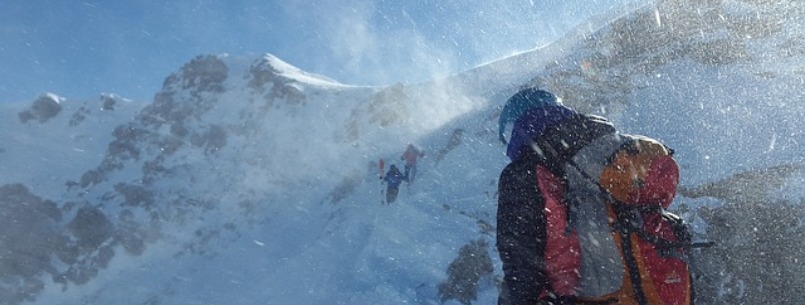Prepare your Body for Skiing
It seems the older I get, skiing seems to get colder. This is from a gal that skied in jeans as a teenager because that appeared to be cool at the time. (Believe me, it wasn’t just cool but freezing, but I looked good). Staying warm isn’t easy and requires a little knowledge and some specialized clothing.
Get plenty of rest the night before you ski and drink plenty of fluids. This is especially important if you are flying in from lower elevations. Drink some juice and have a healthy meal about an hour before you hit the slopes. This helps your body get ready to deal with the cold weather.
What to Wear to Keep Warm While Skiing
The thermal layer is the layer of clothing that is next to your skin. The main purpose of a thermal or “base” layer is to help you with moisture management. Although I find myself choosing different “base” layers depending on the weather, they all “wick” away moisture which in turn helps to keep me dry, comfortable and warm. The best thermal layers are most commonly made out of two fabric types: merino wool and synthetic fabrics. Rather than absorbing moisture, these fabrics all transport, or “wick” perspiration away from your skin, dispersing it on the outer surface where it can evaporate. The result: You stay drier even when you sweat.
Wicking Layer
The wicking layer is worn next to the skin, and “wicks” moisture away from the skin. The purpose is to keep you warm, dry and comfortable. Choose thermal underwear made of synthetic material such as polyester, polypropylene or silk. Avoid cotton clothing such as jeans, sweatshirts, and sweatpants next to the skin, since it absorbs sweat and snow and will make you cold.
Insulating Layer
This layer includes items like sweaters, vests or pullovers. This middle layer keeps heat in and cold out by trapping air between the fibers, so choose a material like fleece, which insulates even when wet and dries quickly, and wool, which has wicking ability.
Protection Layer
Wear a waterproof coat, made of a material such as Gore-tex. Gore-tex allows the sweat and heat inside of the coat to escape, so you stay dry and warm. Wear insulated pants that give an extra lining for really cold days or pants that are water-resistant that allow your skin to breathe.
Headwear and Eyewear
Use a helmet – I just discovered the warming value of helmets. (Check out my post on the pros of wearing a helmet) Fleece and knit hats are good too, but won’t protect your head. Goggles protect your eyes from the wind chill and snow cold on days when it’s snowing. Don’t forget a neck gator – these are very important to keep the wind chill off your neck and face.
Gloves-Mittens and Socks
Mittens are usually warmer than gloves but you don’t have the dexterity as you have in gloves, it’s a personal choice. Having a longer sleeve on the glove helps keep snow from getting in if you fall. I love whoever invented hand warmers, what a genius! Keep several in your pocket to use on those extra-cold days. For socks wear a single, thin pair of wool or acrylic. Most official ski socks have an extra cushion layer over your shins that really help the comfort level of your boots.
Last but not least – if you start to get extremely cold and your fingers or toes get numb, go inside to warm up with a cup of hot chocolate.
Tips on Thermal Layers and Why You Should Buy Now
Sure, it’s time to start thinking about spring skiing but dressing in layers is essential on any cold..or warm ski day. On top of the mountain, it may be windy and cold, and you need to be prepared for this.
Is there a difference between the merino wool and synthetic fabrics?
I find that this really comes down to what you find more comfortable to wear and what your budget is as I have used both and they both provided me with dryness. Personally, I find some of the merino wool products a little itchy on my skin. However, I know many skiers who would never wear anything other than merino wool products.
Cost-wise, the merino wool products, such as Smartwool, Ibex and Icebreaker can be up to two times more expensive than synthetic products such as Hot Chillys and Patagonia Capeline.
Where do I buy a good base layer?
The good news is that base layers are pretty easy to find. This time of year is a great time to think ahead and invest in your thermals. There are great sales around and thermals are less of a fashion item so you need not worry about being in “last season’s” gear. You will be able to find base layers in most retail shops that sell ski, hiking or sport-related products. But I find that online is a great way of shopping around and finding the best deal.
The other good news is that I have found with the correct care of your thermals you can get a lot of wear out of them and they can be with you for many seasons. This is particularly good to know when purchasing thermals for your children as they will no doubt outgrow them before they wear them out.
Remember, a base layer’s purpose is to keep you dry and warm. It pays to invest in some good quality pieces, as there is nothing worse than feeling damp and cold when you are out on the slopes. Plus, there’s nothing like stripping down to your base layer on a warm spring skiing day.
PS: A good thermal layer also helps keeps your kids warm when they decide to have a little sleep on the snow!
